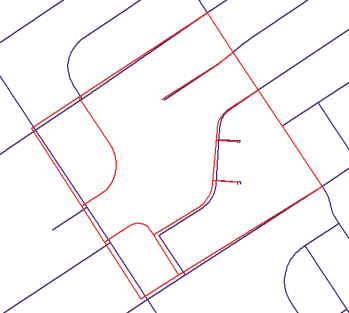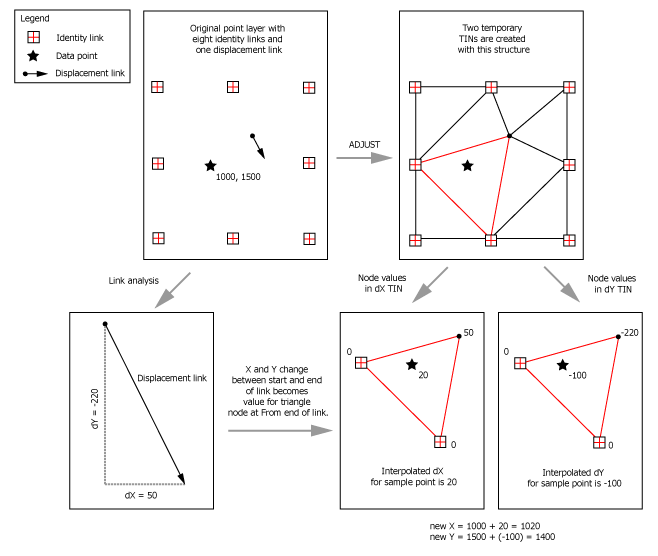Geometric distortions commonly occur in source maps. They may be introduced by imperfect registration in map compilation, lack of geodetic control in source data, or a variety of other causes. Rubbersheeting is used to make small geometric adjustments in your data—usually to align features with more accurate information.

In rubbersheeting adjustments, you are usually trying to align one layer with another that is often in close proximity. The source layer (drawn with solid lines) is adjusted to the more accurate target layer. During rubbersheeting, the surface is literally stretched, moving features using a piecewise transformation that preserves straight lines. During this process, you place links to stretch or warp the data you are trying to align to the underlying datasets.
Similar to transformations, displacement links are used in rubbersheeting to determine where features are moved. The key difference between rubbersheeting and transformations, however, is that the distance features move depends on their proximity to a link and the length of that link. The closer features are to displacement links, the farther they will move.
In some cases, you may not want some features to move at all as they may already be aligned. Locations that are known to be accurate, such as those that already match the target layer, can be held in place with another type of link called an identity link. Identity links "nail" down the surface at the specified point. Additionally, you can define a polygonal area with the Limited Adjustment Area tool to limit a rubbersheet to just that area.
Rubbersheeting is commonly used after a transformation to further refine the accuracy of the features to an existing layer or raster dataset.
Conflation applications use rubbersheeting to align layers in preparation for transferring attributes.
How rubbersheeting works
Rubbersheeting uses two temporary triangulated irregular networks (TINs) to interpolate changes in x (dX) and changes in y (dY) for feature coordinates along user-specified links. Each TIN has the same triangulation structure. The from end of the displacement links and all identity links are used as the TIN triangle corners (nodes). A node is defined by its x,y location and a z-value.
The z-value of each node is used to interpolate the amount of x,y adjustment applied to each feature coordinate. The z-value is the amount of change between the from-end and to-end of a link. For example, if the change in x for a link is 10 map units, the z-value of the TIN node at the from-end of that link will be 10. Since identity links represent no change, the z-value is zero. Once each node of a TIN triangle has a z-value, the corresponding z-value of any point falling on that triangle can be interpolated.
The interpolated z-value from the x-shift TIN is added to the x-ordinal of the feature's coordinate. The z-value interpolated from the y-shift TIN is added to the y-ordinal of the coordinate. For example, if an input feature coordinate is 1000,1500; the interpolated dX for this point is 20; and the interpolated dY is -100, the output coordinates after adjusting will be 1020,1400 (1000 + 20 = 1020 and 1500 + (-100) = 1400).

The rubbersheeting adjustment has two options: linear and natural neighbor. These options refer to the interpolation method used to create the temporary TINs. You can read about these well-known mathematical models online or in the reference texts.
The linear method creates a quick TIN surface but does not really take into account the neighborhood. The linear option will be slightly faster and produces good results when you have many links spread uniformly over the data you are adjusting.
Natural neighbor (similar to inverse distance weighting) is slower but is more accurate when you don't have many displacement links and they are scattered across your dataset. Using linear in this case will be less accurate.
Rubbersheeting data in a geometric network
You can perform spatial adjustments on data participating in a geometric network. For example, you can use rubbersheeting to update utility data in a geometric network to reflect changes in the underlying land base data. It is important to note that the spatial adjustment process will only work against geometric network junctions, so you should place your displacement links appropriately.
During the rubbersheet adjustment, junctions will move and drag any connected lines with them. To preserve the shape of linear features during the adjustment, you should open the Editing Options dialog box, click the General tab, and turn on the option to Stretch geometry proportionately when moving a vertex. For more information about this option, see Moving a vertex without changing a feature's general shape.